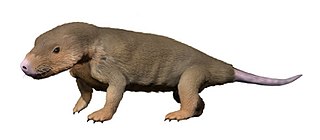 W
WAbdalodon is an extinct genus of late Permian cynodonts, known by its only species A. diastematicus. Abdalodon together with the genus Charassognathus, form the clade Charassognathidae. This clade represents the earliest known cynodonts, and is the first known radiation of Permian cynodonts.
 W
WThe Abrahamskraal Formation is a geological formation and is found in numerous localities in the Northern Cape, Western Cape, and the Eastern Cape of South Africa. It is the lowermost formation of the Adelaide Subgroup of the Beaufort Group, a major geological group that forms part of the greater Karoo Supergroup. It represents the first fully terrestrial geological deposits of the Karoo Basin. Outcrops of the Abrahamskraal Formation are found from the small town Middelpos in its westernmost localities, then around Sutherland, the Moordenaarskaroo north of Laingsburg, Williston, Fraserburg, Leeu-Gamka, Loxton, and Victoria West in the Western Cape and Northern Cape. In the Eastern Cape outcrops are known from Rietbron, north of Klipplaat and Grahamstown, and also southwest of East London.
 W
WAnomocephalus is an extinct genus of primitive anomodonts and belongs to the clade Anomocephaloidea. The name is said to be derived from the Greek word anomos meaning lawless and cephalos meaning head. The proper word for head in Greek is however κεφαλή (kephalē). It is primitive in that it retains a complete set of teeth in both jaws, in contrast to its descendants, the dicynodonts, whose dentition is reduced to only a single pair of tusks, with their jaws covered by a horny beak similar to that of a modern tortoise. However, they are in no way closely related.
 W
WThe Balfour Formation is a geological formation that is found in the Beaufort Group, a major geological group that forms part of the greater Karoo Supergroup in South Africa. The Balfour Formation is the uppermost formation of the Adelaide Subgroup which contains all the Late Permian-aged biozones of the Beaufort Group. Outcrops and exposures of the Balfour Formation are found from east of 24 degrees in the highest mountainous escarpments between Beaufort West and Fraserburg, but most notably in the Winterberg and Sneeuberg mountain ranges near Cradock, the Baviaanskloof river valley, Graaff-Reniet and Nieu Bethesda in the Eastern Cape, and in the southern Free State province.
 W
WBulbasaurus is an extinct genus of dicynodont that is known from the Lopingian epoch of the Late Permian period of what is now South Africa, containing the type and only species B. phylloxyron. It was formerly considered as belonging to Tropidostoma; however, due to numerous differences from Tropidostoma in terms of skull morphology and size, it has been reclassified the earliest known member of the family Geikiidae, and the only member of the group known from the Tropidostoma Assemblage Zone. Within the Geikiidae, it has been placed close to Aulacocephalodon, although a more basal position is not implausible.
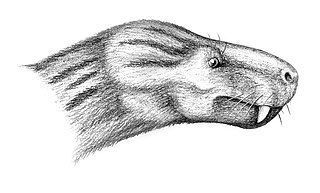 W
WCharassognathus is an extinct genus of Late Permian cynodonts. Described in 2007 from a locality near Fraserburg, South Africa, Charassognathus is the earliest and most basal cynodont. It is known only from the holotype, which dates from the Late Permian Period. The type and only species is C. gracilis. The holotype, found in the Tropidostoma Assemblage Zone of the Teekloof Formation, is made up of a crushed skull, partial lower jaw and one leg.
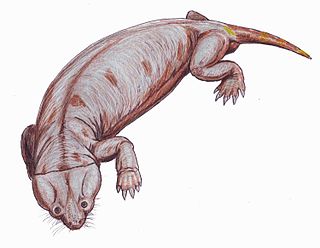 W
WThe Cistecephalus Assemblage Zone is a tetrapod assemblage zone or biozone found in the Adelaide Subgroup of the Beaufort Group, a majorly fossiliferous and geologically important geological group of the Karoo Supergroup in South Africa. This biozone has outcrops located in the Teekloof Formation north-west of Beaufort West in the Western Cape, in the upper Middleton and lower Balfour Formations respectively from Colesberg of the Northern Cape to east of Graaff-Reinet in the Eastern Cape. The Cistecephalus Assemblage Zone is one of eight biozones found in the Beaufort Group, and is considered to be Late Permian in age.
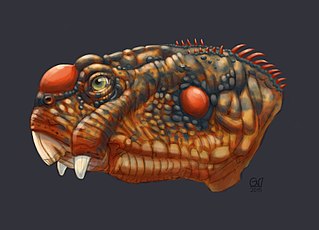 W
WThe Daptocephalus Assemblage Zone is a tetrapod assemblage zone or biozone found in the Adelaide Subgroup of the Beaufort Group, a majorly fossiliferous and geologically important geological Group of the Karoo Supergroup in South Africa. This biozone has outcrops located in the upper Teekloof Formation west of 24°E, the majority of the Balfour Formation east of 24°E, and the Normandien Formation in the north. It has numerous localities which are spread out from Colesberg in the Northern Cape, Graaff-Reniet to Mthatha in the Eastern Cape, and from Bloemfontein to Harrismith in the Free State. The Daptocephalus Assemblage Zone is one of eight biozones found in the Beaufort Group and is considered Late Permian (Lopingian) in age. Its contact with the overlying Lystrosaurus Assemblage Zone marks the Permian-Triassic boundary.
 W
WDicynodontoides is a genus of small to medium-bodied, herbivorous, emydopoid dicynodonts from the Late Permian. The name Dicynodontoides references its “dicynodont-like” appearance due to the caniniform tusks featured by most members of this infraorder. Kingoria, a junior synonym, has been used more widely in the literature than the more obscure Dicynodontoides, which is similar-sounding to another distantly related genus of dicynodont, Dicynodon. Two species are recognized: D. recurvidens from South Africa, and D. nowacki from Tanzania.
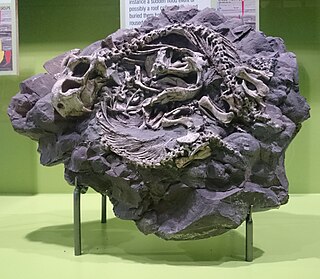 W
WDiictodon was a genus of pylaecephalid dicynodont. These mammal-like synapsids lived during the Late Permian period, approximately 255 million years ago. Fossils have been found in the Cistecephalus Assemblage Zone of the Madumabisa Mudstone of the Luangwa Basin in Zambia and the Tropidostoma Assemblage Zone of the Teekloof Formation, Tapinocephalus Assemblage Zone of the Abrahamskraal Formation, Dicynodon Assemblage Zone of the Balfour Formation, Cistecephalus Assemblage Zone of the Middleton or Balfour Formation of South Africa and the Guodikeng Formation of China. Roughly half of all Permian vertebrate specimens found in South Africa are those of Diictodon. This small herbivorous animal was one of the most successful synapsids in the Permian period.
 W
WDinanomodon is a genus of dicynodont from Late Permian (Changhsingian) of the Lystrosaurus Assemblage Zone, Katberg Formation, and Cistecephalus Assemblage Zone, Balfour Formation Beaufort Group, Karoo Basin of South Africa.
 W
WDinogorgon is a genus of gorgonopsid from the Late Permian of South Africa and Tanzania. The generic name Dinogorgon is derived from Greek, meaning "terrible gorgon", while its species name rubidgei is taken from the surname of renowned Karoo paleontologist, Professor Bruce Rubidge, who has contributed to much of the research conducted on therapsids of the Karoo Basin. The type species of the genus is D. rubidgei.
 W
WThe Dwyka Group is one of four geological groups that compose the Karoo Supergroup. It is the lowermost geological group and heralds the commencement of sedimentation of the Karoo Supergroup. Based on stratigraphic position, lithostratigraphic correlation and palynological analyses, these lowermost Karoo strata range between the Late Carboniferous (Pennsylvanian) to Early Permian in age.
 W
WThe Eodicynodon Assemblage Zone is a tetrapod assemblage zone or biozone which correlates to the Abrahamskraal Formation, Adelaide Subgroup of the Beaufort Group, a fossiliferous and geologically important geological Group of the Karoo Supergroup in South Africa. The thickest outcrops, reaching approximately 620 metres (2,030 ft), occur south-east of Sutherland, north of Prince Albert, and south-east of Beaufort West. The Eodicynodon Assemblage Zone is the lowermost biozone of the Beaufort Group.
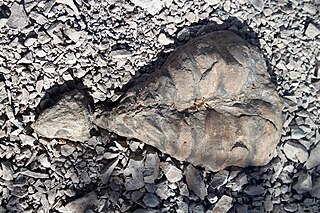 W
WEunotosaurus is an extinct genus of reptile, possibly a close relative of turtles, from the late Middle Permian Karoo Supergroup of South Africa. The Eunotosaurus resided in the swamps of southern Africa. It is often considered as a possible "missing link" between turtles and their prehistoric ancestors. Its ribs were wide and flat, forming broad plates similar to a primitive turtle shell, and the vertebrae were nearly identical to those of some turtles. It is possible that these turtle-like features evolved independently of the same features in turtles, though some studies suggest Eunotosaurus is a genuine, primitive turtle relative. Other anatomical studies and phylogenetic analysis suggest that Eunotosaurus is a parareptile and not a basal turtle.
 W
WGalechirus is an extinct genus of anomodont therapsids. It was about 30 cm (1 ft) long.
 W
WThe Ganigobis Formation is a Late Carboniferous (Gzhelian) to Early Permian (Artinskian) geologic formation of the Dwyka Group in the ǁKaras Region of southeastern Namibia and the Northern Cape of South Africa. The widespread formation was deposited in the Aranos and Karoo Basins of southern Africa.
 W
WIctidosuchoides is an extinct genus of ictidosuchid therocephalians. Fossils have been found from the Karoo Basin in South Africa. The genus is known to have been one of the few therocephalians to have survived the Permian-Triassic extinction event in this area, although its numbers were quite low after the extinction.
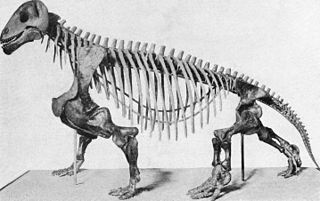 W
WMoschops is an extinct genus of therapsids that lived in the Guadalupian epoch, around 265–260 million years ago. They were heavily built plant eaters, and they may have lived partly in water, as hippopotamuses do. They had short, thick heads and might have competed by head-butting each other. Their elbow joints allowed them to walk with a more mammal-like gait rather than crawling. Their remains were found in the Karoo region of South Africa, belonging to the Tapinocephalus Assemblage Zone. Therapsids, such as Moschops, are synapsids, the dominant land animals in the Permian period, which ended 252 million years ago.
 W
WThe Pristerognathus Assemblage Zone is a tetrapod assemblage zone or biozone which correlates to the upper Abrahamskraal Formation and lowermost Teekloof Formation, Adelaide Subgroup of the Beaufort Group, a fossiliferous and geologically important geological Group of the Karoo Supergroup in South Africa. The thickest outcrops, reaching not more than 300 metres (980 ft), occur just east of Sutherland through to Beaufort West in the south and Victoria West in the north. Exposures are also found west of Colesberg and south of Graaff-Reinet. The Pristerognathus Assemblage Zone is the third biozone of the Beaufort Group.
 W
WProcynosuchus is an extinct genus of cynodonts from the Late Permian. It is considered to be one of the earliest and most basal cynodonts. It was 60 cm (2 ft) long and seems to have been adapted to a semi-aquatic lifestyle.
 W
WThe Tapinocephalus Assemblage Zone is a tetrapod assemblage zone or biozone which correlates to the middle Abrahamskraal Formation, Adelaide Subgroup of the Beaufort Group, a fossiliferous and geologically important geological Group of the Karoo Supergroup in South Africa. The thickest outcrops, reaching approximately 2,000 metres (6,600 ft), occur from Merweville and Leeu-Gamka in its southernmost exposures, from Sutherland through to Beaufort West where outcrops start to only be found in the south-east, north of Oudshoorn and Willowmore, reaching up to areas south of Graaff-Reinet. Its northernmost exposures occur around the towns Fraserburg and Victoria West. The Tapinocephalus Assemblage Zone is the second biozone of the Beaufort Group.
 W
WThe Teekloof Formation is a geological formation that forms part of the Beaufort Group, one of the five geological groups that comprises the Karoo Supergroup in South Africa. The Teekloof Formation is the uppermost formation of Adelaide Subgroup deposits West of 24ºE and contains Middle to Late Permian-aged deposits and four biozones of the Beaufort Group. It overlies the Abrahamskraal Formation. The Teekloof Formation does not underlie other units other than the younger Karoo dolerites and sills that relate to the emplacement of the Early Jurassic Drakensberg Group to the east. Outcrops and exposures of the Teekloof Formation range from Sutherland through the mountain escarpments between Fraserburg and Beaufort West. The northernmost localities of the Teekloof Formation are found by Loxton, Victoria West and Richmond.
 W
WThliptosaurus is an extinct genus of small kingoriid dicynodont from the latest Permian period of the Karoo Basin in KwaZulu-Natal, South Africa. It contains the type and only known species T. imperforatus. Thliptosaurus is from the upper Daptocephalus Assemblage Zone, making it one of the youngest Permian dicynodonts known, living just prior to the Permian mass extinction. It also represents one of the few small bodied dicynodonts to exist at this time, when most other dicynodonts had large body sizes and many small dicynodonts had gone extinct. The unexpected discovery of Thliptosaurus in a region of the Karoo outside of the historically sampled localities suggests that it may have been part of an endemic local fauna not found in these historic sites. Such under-sampled localities may contain 'hidden diversities' of Permian faunas that are unknown from traditional samples. Thliptosaurus is also unusual for dicynodonts as it lacks a pineal foramen, suggesting that it played a much less important role in thermoregulation than it did for other dicynodonts.
 W
WThe Tropidostoma Assemblage Zone is a tetrapod assemblage zone or biozone which correlates to the lower Teekloof Formation, Adelaide Subgroup of the Beaufort Group, a fossiliferous and geologically important geological Group of the Karoo Supergroup in South Africa. The thickest outcrops, reaching approximately 240 metres (790 ft), occur from east of Sutherland through to Beaufort West and Victoria West, to areas south of Graaff-Reinet. Its northernmost exposures occur west/north-west of Colesberg. The Tropidostoma Assemblage Zone is the fourth biozone of the Beaufort Group.
 W
WThe Whitehill Formation, alternatively written as White Hill Formation and formerly known as White Band or Whitehill or White Hill Member, is a regional Early Permian geologic formation belonging to the Ecca Group in the southeastern ǁKaras Region of southeastern Namibia and Eastern, Northern and Western Cape provinces of South Africa.
 W
WYoungina is an extinct genus of diapsid reptile from the Late Permian Beaufort Group of the Karoo Red Beds of South Africa. This, and a few related forms, make up the family Younginidae, within the Order Eosuchia. Eosuchia, having become a wastebasket taxon for many probably distantly-related primitive diapsid reptiles ranging from the Late Carboniferous to the Eocene, Romer proposed that it be replaced by Younginiformes.